Aglaonema: description, home care and reproduction
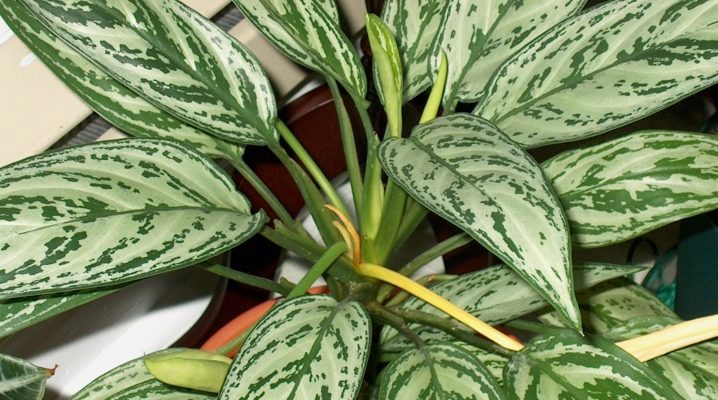
Indoor plants have been popular for a long time. This is a great way to freshen up an interior without a huge investment. But, in addition to beauty, they also bring benefits to those who are often with them in the room. It doesn't matter if it is a residential apartment, office or public place. The benefits of indoor plants are a proven fact. One of the popular room neighbors is a culture called aglaonema.

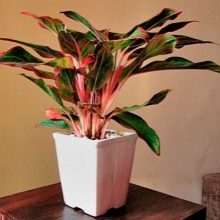
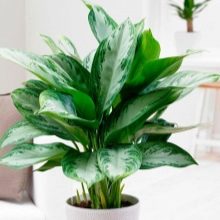
Peculiarities
Aglaonema is a plant with a lush crown, the leaves of which remain green all year round. The homeland of the flower is Southeast Asia. He arrived in our latitudes from the expanses of China, the Philippine Islands, New Guinea, India or even Sumatra. Its habitat in natural conditions is quite extensive. As a houseplant, aglaonema has gained its popularity due to its brightness, beautiful color and interesting flowers.
Aglaonema belongs to the same Aroid family together with Dieffenbachia. Hence the belief of many that she is as poisonous as her larger-leaved sister in the family.
However, aglaonema is not as toxic as dieffenbachia. But at the same time, when working with it, it is better to be careful - flower juice can irritate the skin and mucous membranes.


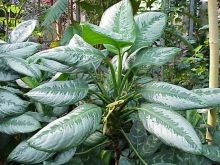
The description of a plant is highly dependent on its species. The number of varieties of aglaonema exceeds a dozen. Different species can be radically different from each other: there are aglaonema high and low, more or less lush, with large and wide leaves or with thin and long ones. The appearance and care features depend on each specific species and variety of plants.
Despite the fact that the plant arrived from warm regions, it has taken root quite well in latitudes with cold climates. The care they need when cultivating in apartments or offices is enough for the plant to live for a very long time. Many species and varieties of Aglaonem are very unassuming and loyal. Although there are also flowers that are more sensitive to detail.
Aglaonems are distinguished by enviable vitality. Of course, life expectancy can vary greatly depending on the type of flower and its living conditions. But on average, the owners of such indoor plants note that aglaonema lives for at least 20 years.



Bloom
In aglaonema, like in other plants of the Aroid family, the flower looks like a small ear, which is wrapped in a “blanket” of light green cloth, similar to a delicate leaf. The final appearance of the flower depends largely on the type of aglaonema and can be of different shapes and sizes.
At the end of flowering, berries are formed. They mature for a long time. One berry can live on a plant for up to six months or even more. The berries are poisonous and it is forbidden to eat them.
In its homeland, in Southeast Asia, aglaonema blooms in summer - from June to August. However, in our latitudes, the flowering period can be strongly shifted towards winter and occurs approximately from November to February. In indoor conditions, some types of aglaonema bloom quite rarely. And if all the advice on its content is not followed, it, if it does not die, may stop blooming altogether.
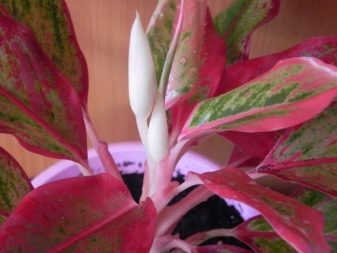
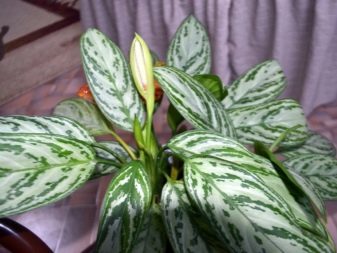
Varieties
There are not a lot of varieties of aglaonem today. If you list them all, there are more than 50 pieces. Among them there are also hybrid varieties.
The most famous types of aglaonema, on the basis of which many varieties have been bred.
- Aglaonema is simple. The most typical representative of the species. It grows in nature mainly in swamps and grows no higher than 35 cm. The leaves of a simple aglaonema on average reach 17 cm in length and 7 cm in width. They are monochrome and most often dark green.
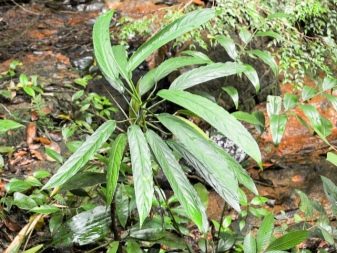
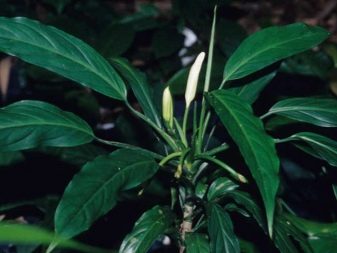
- Aglaonema is changeable, it is changeable. A plant characterized by the variegation of its leaves. It can grow up to a maximum of 1 m in height. The stem of the variable aglaonema can become bare at the roots over time when the flower grows too tall. This is solved by rejuvenating the plant - its top is rooted.
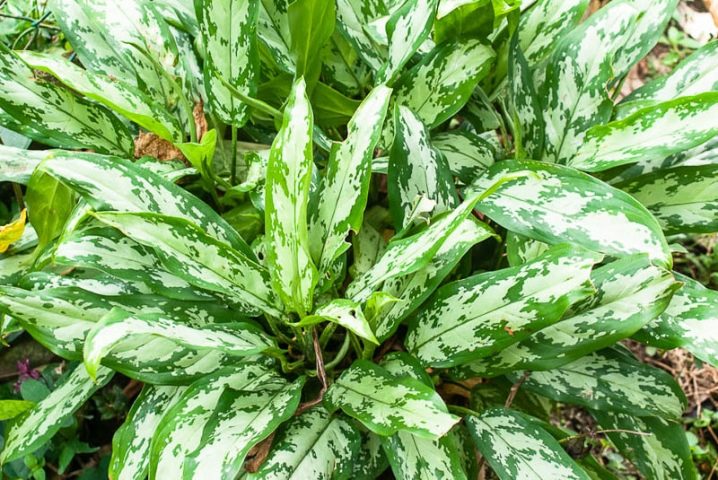
- Aglaonema is brilliant. It has large leaves that can grow up to 45 cm in length. They are distinguished by an oblong appearance, more like grass than leaves of trees or shrubs. The color of the leaves ranges from bright to dark green.
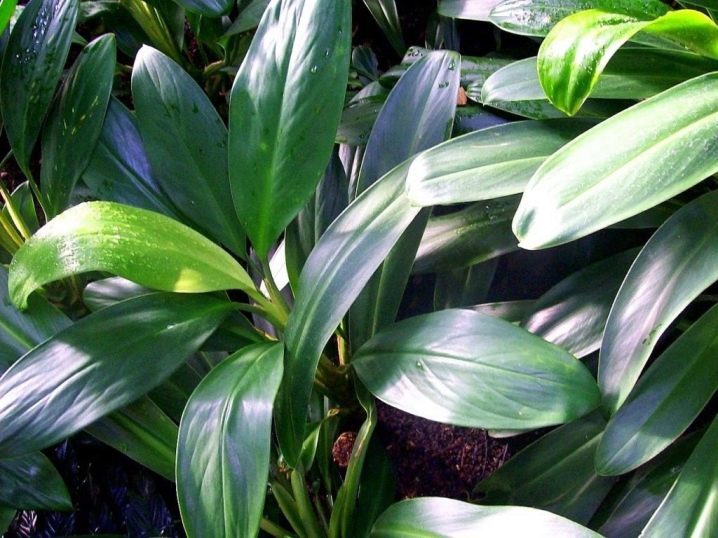
- Aglaonema humble, or moderate aglaonema. Not a very tall plant - it does not outgrow the 50 cm mark. The modest aglaonema has oval leaves of a uniform green color, growing up to 20 cm in length. Its fruits are similar to dogwood.
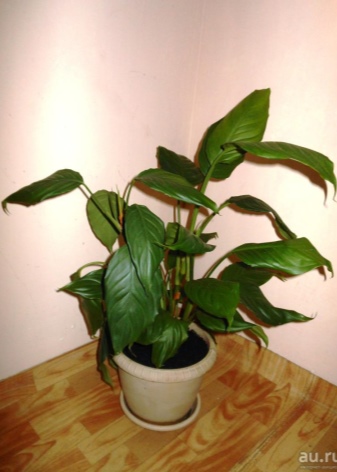
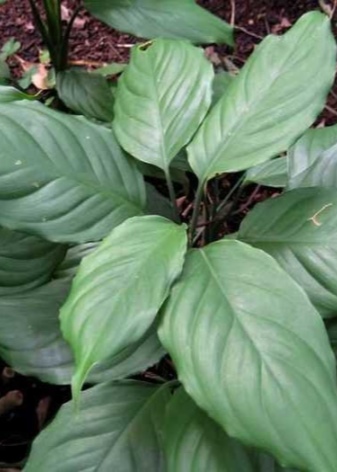
- Painted Aglaonema. It grows to about 60 cm in height. A distinctive feature of this flower is spotted elongated leaves. Spot colors can range from gray to silvery white, bright green to deep dark.

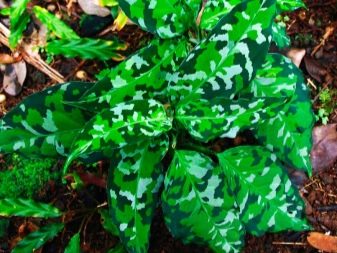
- Aglaonema curly. It usually looks like a highly branched bush, which is abundantly strewn with leaves. The leaves can be up to 30 cm long. It has a dark green edging and a silvery green core.
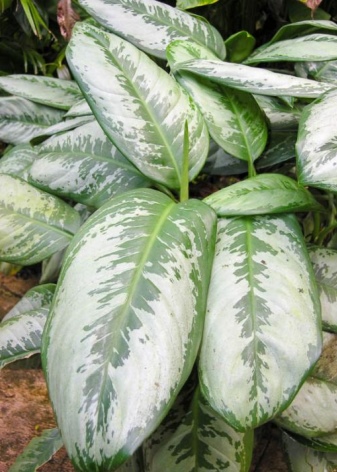
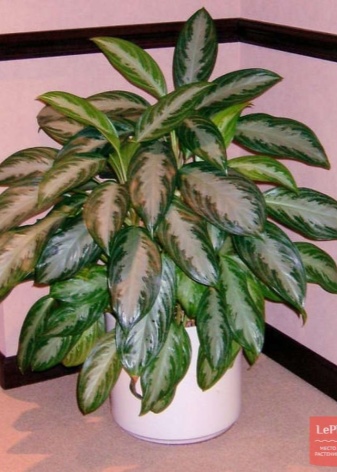
- Aglaonema rounded differs in thick leaves of an almost round shape, only slightly pointed upwards. Brightness to the leaves is given by thin veins of contrasting colors, depending on the plant variety. Also a distinctive feature is her short stature. On the basis of this particular species, red aglaonemes were derived.
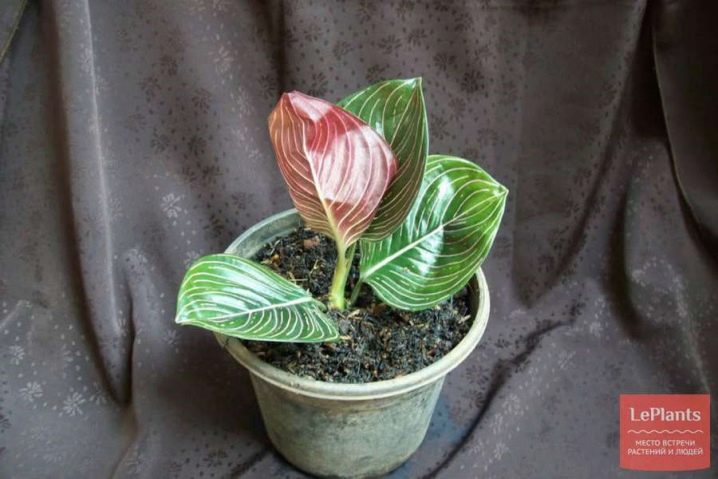
- Aglaonema ribbed differs in its leaves, which is why it got its name. Its leaves can grow up to 20 cm in length and have an oval-elongated shape. Their striking feature is their colors. The streaming of ribbed aglaonema is dark green with contrasting strokes all over their surface.
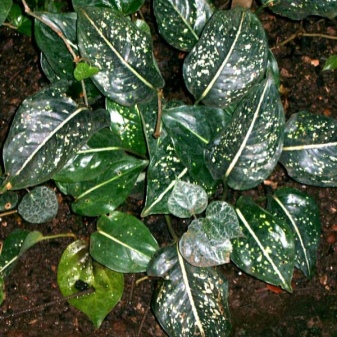
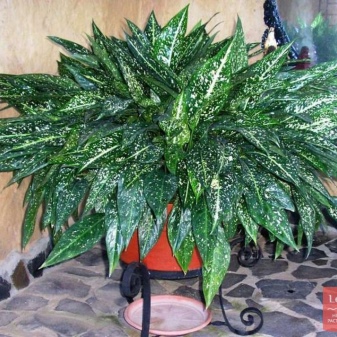
- Aglaonema pseudo-bracts, also known as pseudo-vellum. This species is distinguished by spear-shaped leaves of a bright rich green color with beautiful interspersed with cream shades.
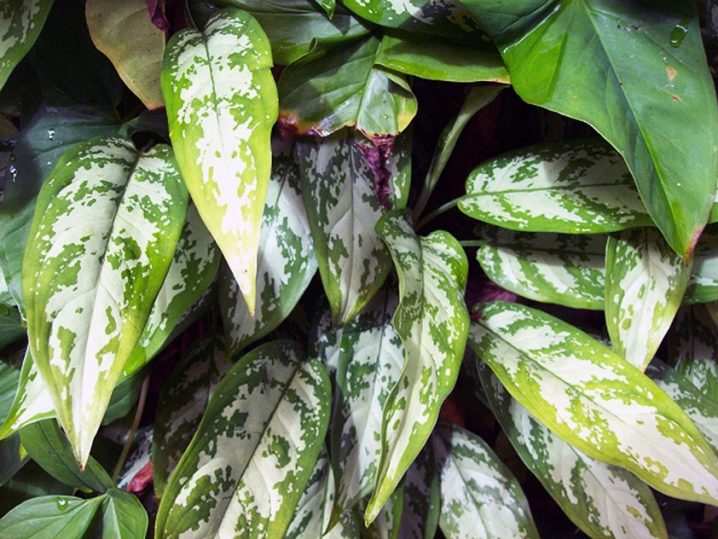
If we talk about popular varieties of aglaonem, then the list is much larger. Therefore, it is better to consider only the most popular of them, which can be found more often than others on the windowsills of apartments and offices of the Eurasian continent.
- "Silver Queen", there is also the name "Silver Queen" (from the English Silver Queen) - this is one of the most common plant varieties. The flower leaves are very light, may have a dark edging and small blotches throughout their area. The popularity of the "Silver Queen" is due not only to its interesting appearance, but also to the relative simplicity of care.
In countries with warm climates, it can even be planted outdoors. Of all the varieties, the "Queen" blooms the best of all - consistently once a year.
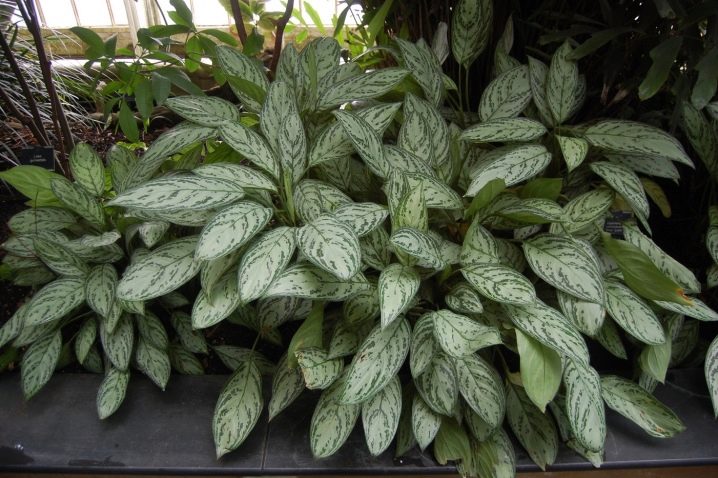
- Red aglaonema albeit not too often found, it looks no less impressive from this. This variety was bred by selection and is distinguished by the red color of the leaves. There are two varieties of red aglaonema: "Crete" and "Butterfly". Aglaonema "Crete" grows very slowly, and, while young, has a completely red color of the leaves, but with age they turn green. At the same time, the central vein of the leaf remains red until the very end of life. Aglaonema "Butterfly" has green leaves with a pale pink vein and the same blotches that are associated with the wings of butterflies.
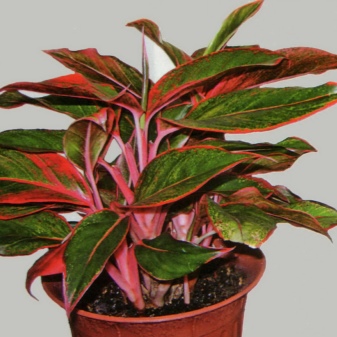
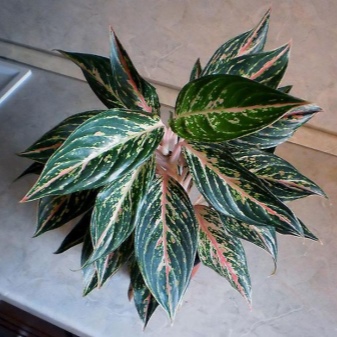
- "King of Siam", aka "King of Siam", - a fairly tall plant. The flower reaches a height of 120 cm. The leaves of the plant are large and pointed, rich green in color with slightly contrasting veins.
One of the distinguishing features of this variety is that its stem stiffens with age. This variety is particularly tender and light-requiring.
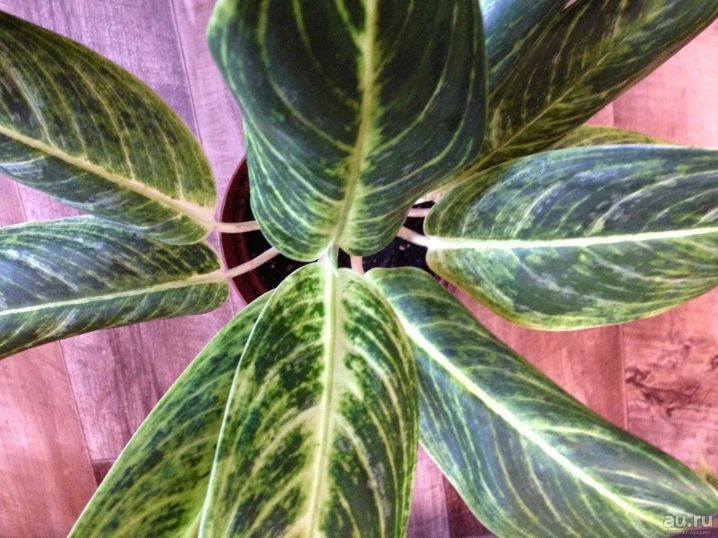
- Cutlass may be referred to as Cutless. A variety characterized by elongated, but pointed leaves of a light shade with a dark edging and the same dark blotches. This plant rarely blooms at home and requires a lot of heat and light for its maintenance.
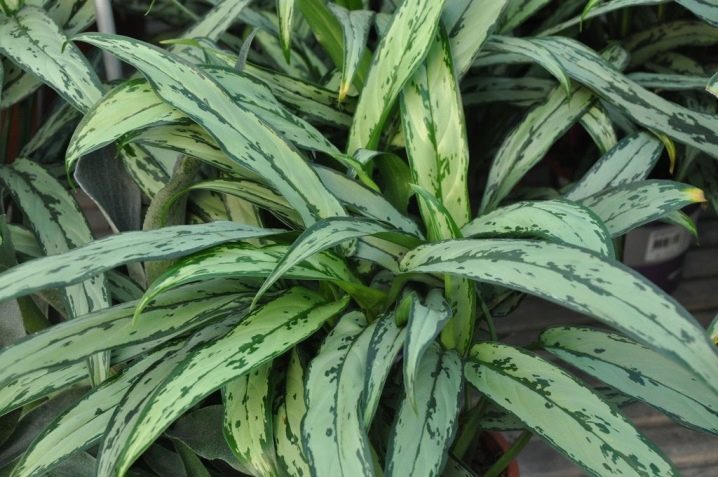
- "Treiba" It has a very branched trunk, which can reach a height of 1 m.Only without support, the trunk usually begins to bend after growing 50 cm.Therefore, if it is important to grow the plant as even as possible, it will be necessary to tie it up and provide support. The leaves of "Treiba" are oval with elongated tips. They can grow up to 30 cm in length. The color of the leaves is quite variegated: the leaves themselves are rich green with light blotches. They spread from the core of the sheet to the edges.
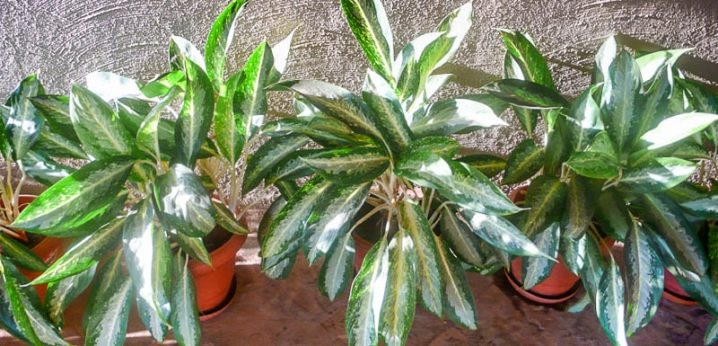
- "Tricolor" - the most popular variety of painted aglaonema. On the wide leaves of the plant there is a scattering of bright green spots, and the core of the leaf is distinguished by a contrasting light tone.
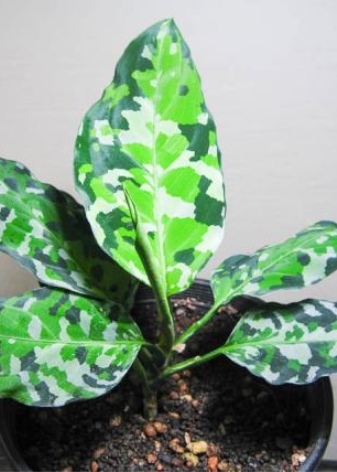

- "Super White", aka "Super White" - one of the most extravagant varieties. This flower differs from its relatives in very light, almost white leaves with a beautiful dark edging.
The plant is very capricious, but in order for the leaves to remain outlandishly light, it needs to provide a good flow of diffused light.

Conditions of detention
Since aglaonema came to us from latitudes with a tropical climate, special conditions are required to keep it at home. If you ignore them and do not provide the flower with everything it needs, there is a chance to kill it.
It is very important to ensure the following things at the proper level:
- lighting;
- temperature and humidity.
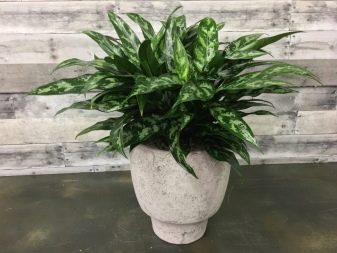
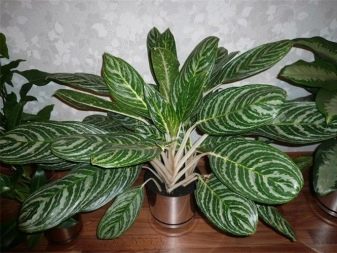
Despite the fact that the homeland of Aglaonema is the tropics, it does not like direct sunlight. If they get on the leaves, they will definitely result in a burn. It is best to provide a flower with a uniform color of leaves a pleasant partial shade.
For aglaonemas, which are distinguished by a pronounced pattern on the leaves, you need to provide diffused sunlight. If you hide them in the shade, the pattern on the old leaves will disappear, and on the new ones it will not appear at all.
The most pleasant temperature for aglaonema is the range from 20 to 25 ° C. In winter, the temperature is required an order of magnitude lower - from 16 to 18 ° C.
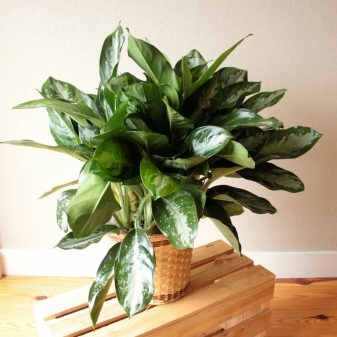
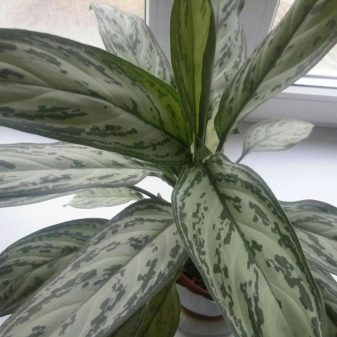
The general rule for all types of plants of this species is that they cannot tolerate sudden changes in temperature. It is important to protect them from hypothermia or overheating, as well as from drafts.v. Some of the species and varieties may be more tenacious and can endure such conditions than their counterparts, but this is rather an exception. Therefore, it is important to find a good location for the flower, away from drafts, batteries or under the sun.
Humidity is very high in most regions of Southeast Asia. Therefore, the plants that come from there require about the same level of humidity in order to feel comfortable. For most aggloanems, the usual humidity level that prevails in an average room will not be suitable.
If the moisture level is insufficient, the leaves of the plant will begin to turn yellow and dry. To prevent this from happening, it is best to spray the plant. You can also place the pot on a special tray filled with moistened peat or pebbles.
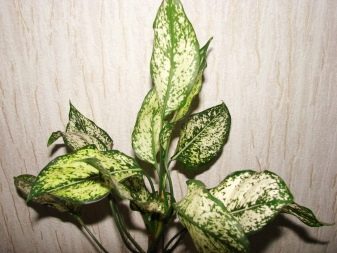

Transfer
Aglaonema is a plant that grows very slowly, so transplanting is not a frequent event for it. For these flowers, it is also important to transplant periodically to renew the soil. But this is done much less often than for other indoor plants.
Young flowers are transplanted no more than once a year, and on average, the frequency can reach one and a half years. Adult plants are transplanted every 3-5 years.
The most favorable time for transplanting is late spring. Aglaonema loves wide pots.Instead of soil, you need to use a soil mixture, which includes 1 part of humus, 6 parts of leaves, 2 parts of sand and peat, 1 part of charcoal. You can also use a substrate of 1 part sand, 1 part peat, and 2 parts leafy soil with a little charcoal added.
An important component of any transplant is a good drainage layer. It should be located at the bottom of the pot. If this condition is ignored, the circulation of water in the soil will be disrupted, which will lead to its stagnation. And stagnant water can lead to decay of the roots and death of the plant.
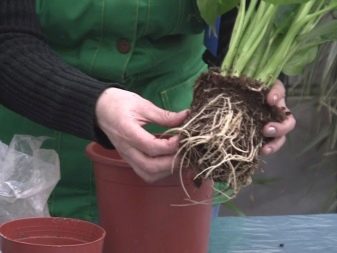

How to care?
Watering and feeding are two important components of caring for an agglomerate at home. The irrigation regime should not be violated, and top dressing should not be ignored. Then the plant will receive the necessary level of moisture and all the substances it needs for full life and development.
Do not water the plant with water directly from the tap. The water you need is soft. To soften water for 1 liter, add 0.2 grams of oxalic acid. You can replace it with lemon. The solution must be defended for at least a day before use. Watering with cold water is contraindicated, it is better to use water at room temperature or even slightly warm.
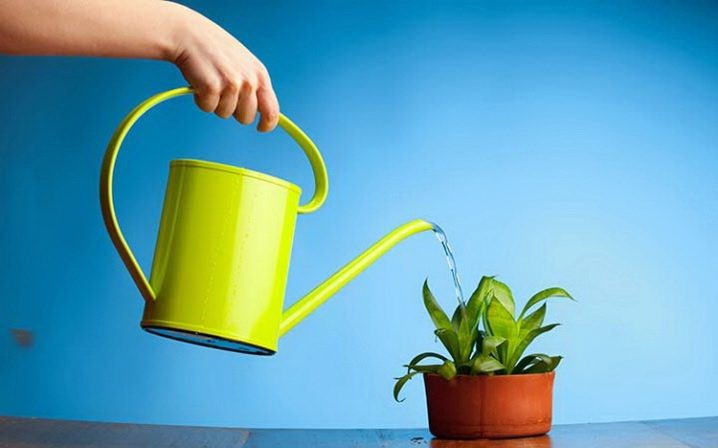
The watering regime depends on the season. In the spring and summer, watering is carried out every time when visually the topsoil begins to dry out. It is very important not to let the deep soil layers dry out. This can damage the roots of the plant. In late autumn and winter, you need to water the plant a couple of days after the topsoil has dried.
At any time of the year, you cannot water the plant too abundantly. It doesn't like excess fluid. This can lead to stagnation in the pot.
The leaves of the plant need constant moisture. To do this, they need to be sprayed from a spray bottle with the same water that is used for irrigation.

As for feeding, the flower does not need it in winter. It is not worth starting to apply fertilizers to the soil until the end of winter. The first days of spring are a great time to take care of agglomeration. The frequency of feeding is once every two weeks.
It is best to combine organic and mineral fertilizers. You don't need to invent anything: fertilizers need to be diluted in the proportions indicated by the manufacturer. Also, the dosage for the plant is selected according to the manufacturer's recommendations. For aglaonem, any fertilizer for deciduous indoor flowers is suitable.

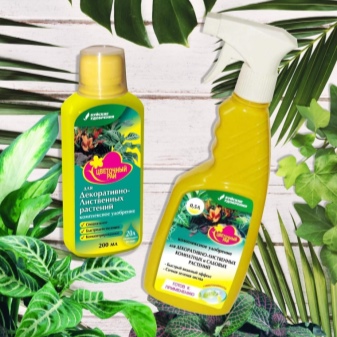
Fertilizers are best suited in liquid form. This will evenly saturate the soil with them. But it is worth observing an important condition: you cannot feed the flower at the same time as watering.
Top dressing with liquid fertilizer occurs 3-4 hours after watering. By this time, the soil will be well moistened, and nutrients will be evenly distributed throughout the soil.
With the arrival of autumn, feeding should be gradually reduced in order to stop completely by winter until next spring. If the need arises, then in winter you can also feed the flower. Only this is done much less often: once every six weeks.
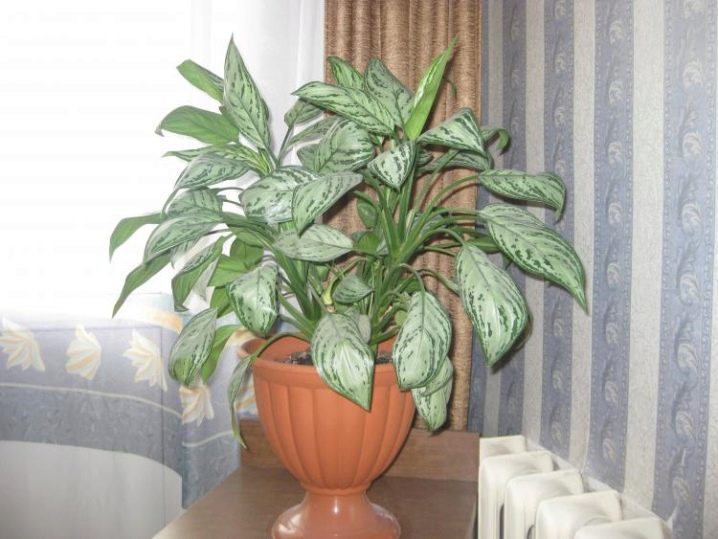
Reproduction
Reproduction is best done in late spring or summer. Otherwise, a mini greenhouse should be used to provide the cuttings with warmth and to protect them from possible temperature changes.
The main safety rule when working with aggloanema during its reproduction, when it has to be cut, is to protect the skin of the hands. It is best to use protective gloves, and after contact with plant cuttings, hands should be thoroughly washed with soap.
The sap of the plant can cause itching and irritation of the skin and get through the hands on the mucous membranes and in the eyes.
Aglaonema can be propagated in several ways:
- grafting:
- seeds;
- division.

Propagation by cuttings is a standard procedure in which the top of the stem is cut off. It should be a stem with an apical cutting. Cuttings can be carried out only after the stalk of the aglaonema has grown sufficiently and acquired branches.
The length of the cut stem can be any. If it is very long and you plan to divide it into several cuttings, you should make sure that each of them will have a leaf. Otherwise, it is unlikely that it will be possible to root it in the end. Prepared cuttings should be left in the fresh air for a day so that they dry out. Before this, the cut should be processed with chopped charcoal.
The next day, the cuttings need to be deepened into the soil prepared for the sprouts by 5 cm. The soil should be composed of sand and peat. Roots will only take root when there is enough heat. Therefore, they must be removed to a place with a temperature of at least 22 ° C.
The roots will appear within the next month. This time can be accelerated by using the underfloor heating. Then the cuttings can take root within 20 days. Then they are transplanted into pots with a substrate that is used for adult plants.

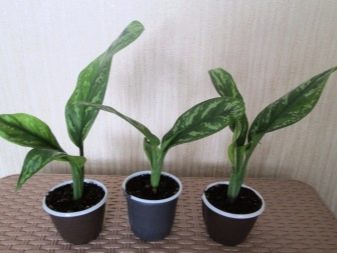
In nature, aglaonema reproduces on its own. And this can be repeated at home if the plant is blooming and bearing fruit. To do this, it is necessary to provide proper care for it and satisfy all needs in the form of temperature, watering, fertilizing and other things.
The leaf-like flap that surrounds the ear of a flower is not just a decoration. It helps the flower to self-pollinate, that is, it does not even require the participation of insects for this. In this case, seeds may appear, from which a new plant can also be obtained. For this, it is important to wait for the fruit to ripen directly on the branches of the flower.
Important note: when propagating from seeds, it is not always possible to preserve the distinctive features of the variety. As a result, a young plant may not look exactly like its parent.
Before sowing, the seeds must be carefully removed from the fruit and rinsed under running water. They are not subject to storage - they must be dropped off immediately. Aglaonema seeds lose their ability to sprout too quickly. You need to plant seeds in low containers. Sand and peat should be used as a substrate in a 1: 1 ratio. The containers must be removed to a warm place and watered from time to time.
The seeds germinate quickly enough that it is not difficult to propagate the flower in this way. The first shoots will appear quickly. It is necessary to transplant young plants after they have formed enough and acquire pronounced leaves.

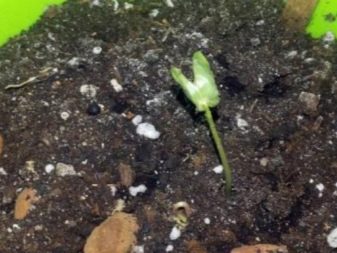
Another type of reproduction is division. It can be done when transplanting a plant. When the aglaonema has grown into an overly lush bush, it can be neatly divided into several. To do this, you need to cut the rhizome into two or more parts, and plant each in its own pot.
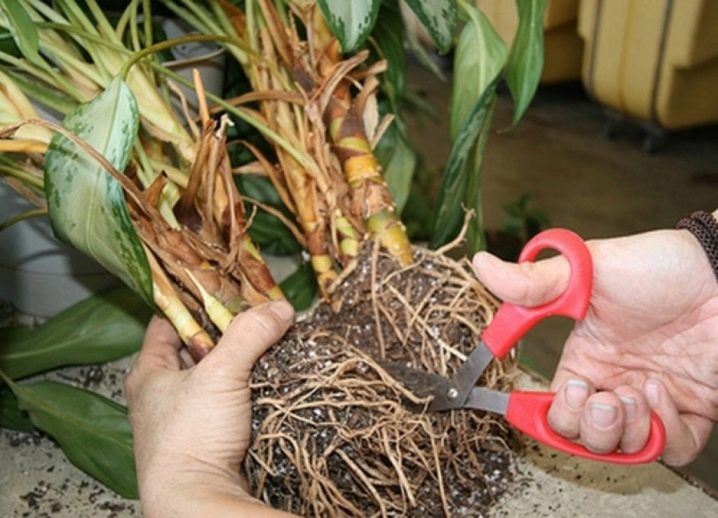
Diseases and pests
Like any living creature, aglaonema can feel bad, and this will certainly affect its vitality. It is not susceptible to disease, but can be attacked by insects. She also suffers greatly from improper care.
It is important to do everything possible to identify and rule out the causes of the condition, and to provide the necessary treatment, if needed. If nothing is done, the plant may die. Because any disturbances in its functioning are attempts to signal that something is wrong with it.
If the plant begins to curl the leaves, then most likely it has frozen. If the foliage has curled into a tube, and the edges of the leaves begin to darken, these are symptoms of the same problem. You need to see if the temperature in the room has dropped, and check if the pot has gotten into a draft.
The leaves of the aglaonema were covered with atypical light yellow spots or specks - most likely, the flower has a burn. It is urgent to remove the pot with the plant from under the sun and provide it with the necessary partial shade. If the leaves are properly moistened by spraying them with warm soft water, they will recover.
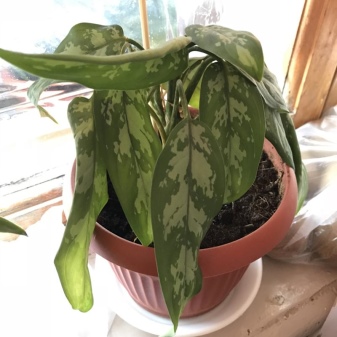

Aglaonema can be very slow in growth, and foliage can begin to change color to an unhealthy brown. These are symptoms of poor watering.Most likely, either cold or hard water was used. Only soft and warm water is suitable for a flower.
Aglaonema leaves may wrinkle and brown around the edges. If this happens, and the plant visually dries up, this signals that there is not enough moisture in the room for the flower. This can also cause harmful insects to multiply on the plant. Therefore, it is important to maintain the required moisture level and constantly spray the plant.
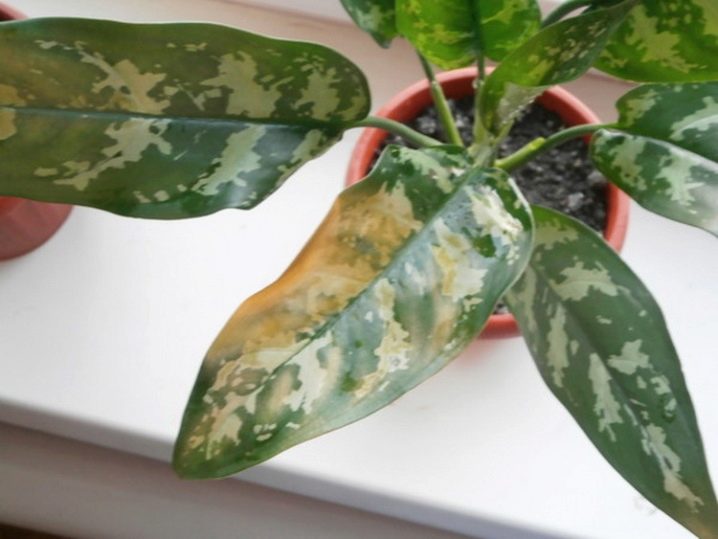
If the leaves turn yellow, there may be 2 reasons for this.
- Perhaps the flower is too cramped in its current pot, and the soil is already too depleted. In this case, a transplant will help. The pot needs to be chosen a couple of sizes larger, and a new one must be added to the old soil. Two weeks after transplanting, carry out the first feeding of the flower. The latter will provide him with all the necessary nutrients for recovery and continued existence.
- The flower dies due to the fact that it was too dry. There is insufficient watering and, possibly, insufficient moisture in the leaves. In this case, the roots suffer, and this damage can no longer be restored. The only way to save the plant is to quickly cut off the cuttings and root them in new soil. The roots left over from the old flower can only be thrown away.
In the case when the tips of the aglaonema leaves turn black, an urgent need to check the temperature regime. Blackening of the leaves indicates that the plant is freezing. Perhaps the pot was in a draft or the temperature in the room dropped dramatically. In this case, you need to quickly warm up the plant and provide it with the required level of heat again.

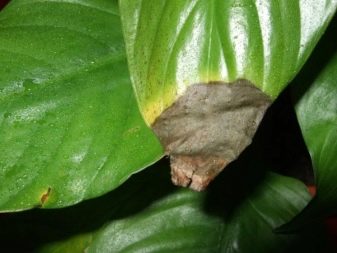
From insects on aglaonema, aphids, mealybugs and spider mites can breed. It is impossible to ignore the appearance of pests, you need to get rid of them and cure the plant.
If the leaves are covered with a light cobweb, then the plant was attacked by a spider mite. If nothing is done, the leaves affected by the mite will eventually fade, and then completely fall off. In this case, the pest will continue to capture more and more new leaves.
In order to cure aglaonema, all damaged leaves must be carefully removed. The plant is completely treated with an insecticide (for example, "Actellic").
The appearance of a tick signals that the air in the room is too dry. Therefore, it is necessary not only to remove insects, but also to provide the plant with the required level of moisture.
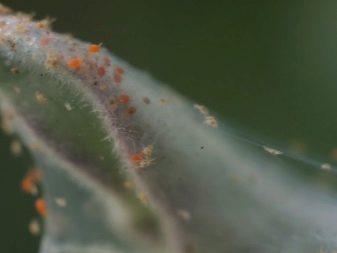
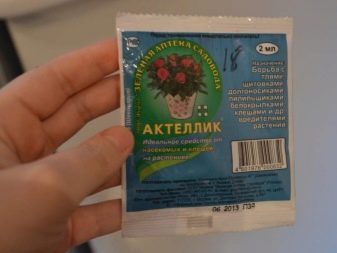
The mealybug on the plant looks like a bloom of white fluffy balls. If these insects are on the aglaonema, you need to treat it with soapy water. Use regular brown laundry soap for the solution. It is most convenient to grate it on a fine grater and dissolve the resulting shavings in water. The solution should be cloudy, but not white like milk. It is better to repeat the treatment with soapy water after 5-7 days to consolidate the result.
Aphids are very small insects (up to 5 mm in size) that actively attack leaves, young shoots or flower buds. To get rid of it, the plant must be treated with a solution of pyrethrum or tobacco. If the infestation is very strong and there are too many insects, you can also treat it with Aktellik. The treatment can be repeated after a few days, if necessary.

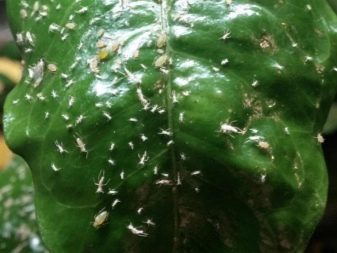
For information on how to properly care for an aglaonema, see the next video.

























The comment was sent successfully.